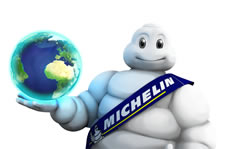Environment introduction
 |
Greenhouse effect, consumption of natural resources, elimination of waste, noise pollution and new regulations... 8 steps to help minimise your fuel consumption
- Service your car regularly.
- Drive Smoothly. Change gears between 2,000 to 2,500 rpm.
- Check you tyre pressures. Correctly Inflate tyres to optimise fuel consumption and grip.
- Use air-conditioning sparingly.
- Keep Windows closed at high speeds.
- Consider turning off the engine when the car is at a standstill.
- Drive light. A reduced car load means less fuel consumption and emissions.
- Limit the use of electrical appliances.
|
Managing the production of natural rubber
 |
Michelin uses around 10% of the global production of natural rubber.
70% of the global production of natural rubber is used by the tyre industry.
The number of vehicles is set to increase from 900 million to 1.6 billion over the next 20 to 30 years. The polymers derived from petroleum, itself becoming rare, will not be a substitute for natural rubber.
- It is therefore essential to:
- Encourage more productive rubber tree farming.
- Secure sustainable supply as far as possible.
- Promote optimized agroforestry models.
- Have a responsible procurement policy that secures medium and long-term prices.
- Support agronomic research to create sustainable rubber tree farming
|
Reducing the impact of tyres during use
 |
Under-inflated tyres mean increased fuel consumption and CO2 emissions, whilst braking becomes less efficient and the tyres wear more quickly.
Another initiative involves reducing noise levels by producing increasingly quiet tyres. |
Recovering and reusing end-of-life tyres
Today, fewer and fewer used tyres are ending up in landfill or dumps as new recycling possibilities are developed and more people become aware of the ecological stakes involved.
Used tyres are 100% recovered either as secondary raw material or as alternative energy.
Whole, shredded, or ground into crumbs or powder, end-of-life tyres (ELTs) are used in filling material, noise-resistant walls, railroad track crossings, draining sub-layers and synthetic surfaces for sports fields and playgrounds.
What’s next?
You’ve nearly made it to the end! The next module in the last and here we take a close look at Performance Driving.
If you’ve ever watched motorsport on TV, you’ll have heard the commentators talk extensively about the tyres. In this module, we concentrate on track driving and the impact tyre choice and pressures can have on lap times. |

